Abstract
Since the advent of the 21st century, with the promulgation of landscape laws and related landscape management regulations, city color, as a vital component of the urban landscape, has garnered increasing attention. In East Asia, numerous cities have embraced city color planning as a means to enhance their urban landscape and shape the distinctive features of the city. Therefore, this study focuses on exploring the characteristics of city color planning systems in East Asia by adopting qualitative analysis methods, using Tokyo, Seoul, and Beijing as case study examples. We used publications, academic research, and official documents clustered into seven domains to identify the following: government agency, introduction time, relevant laws, upper plan, tools/management, planning method, and planning contents. The results revealed that compared with Europe, city color planning in East Asia is government-led top-down planning, and there are remarkable similarities in the formulation process, planning methods, and color selection, while there are obvious deficiencies in the professionalism of the planning authorities and public participation. The results of this study provide a valuable reference for city color planning in the future, thereby enhancing the urban landscape and shaping unique city identities in East Asia.
1. Introduction
Human experience is largely shaped by perceptions, which involve the processing and interpretation of information gathered from the environment. Our sensory organs collect these perceptions, with the visual sense contributing to 87% of all stimuli and color accounting for 70% of that visual input (Correy 1982). As such, color has been the subject of extensive research by scholars across many fields. Within the realm of urban environments, the concept of city color encompasses the perceptible colors of all visual objects within a city, including artificial colors, such as those of buildings, external facilities, roads, and billboards, and natural colors, such as those of mountains, rivers, rocks, vegetation, and other natural elements (Chen et al. 2022). City color is not only an essential part of the urban landscape but also a carrier of a city’s history and culture. It profoundly reflects social civilization and influences urban life quality (Behbudi et al. 2012). Therefore, many cities worldwide have incorporated color into the management system of their urban landscape, such as Turin, Prato, Osaka, and Tokyo (Hong et al. 2022).
In fact, color control in East Asia can be traced back to the five elements and five colors theory of ancient China. As early as the Zhou Dynasty, the five colors of cyan, red, yellow, white, and black were established as positive colors and given different grades (Lv 2008). Since then, this tradition of color grades has continued. Although the color grades of different dynasties are different, in general, the five colors are respected. Furthermore, five colors theory, and the use of color to indicate rank, spread from ancient China to Korea and Japan (Dusenbury 2015). Therefore, a pattern of palaces and temple buildings having rich colors, especially yellow, red, and cyan in the five colors, and general dwellings having monotonous colors, especially grey, black, and white, was formed in ancient East Asia (Li 2016). However, as the feudal dynasty fell, so did the five colors hierarchy, coupled with the industrial production of chemical colors, leading to greater freedom in color choices.
In the 20th century, this color freedom, coupled with a lack of color knowledge, resulted in confusion regarding the use of architectural colors. Rapid urbanization exacerbated the situation, leading to urban landscape issues such as color noise, color disharmony, and color convergence in many cities across China, Japan, and South Korea (Wang et al. 2020). Recognizing the gravity and urgency of this problem, scholars and city managers gradually began introducing policies and measures to standardize the city colors and enhance the city’s image and characteristics. Specifically, in 1968, Kanazawa City in Japan formulated its first landscape ordinance, considering the impact of color on the urban landscape in East Asia (Wang 2019). Thereafter, in the 1970s, as French colorist Jean Philippe Lenclos’s concept of “the geography of color” extended into the Asian region, color research gained importance, especially in Japan (Kodera 1993). In 1978, Kobe promulgated the “City Landscape Regulations”, which made urban colors a statutory component (Nakao 1990). Since then, Kyoto, Nagoya, and other cities have tried to develop urban landscape regulations and city color planning (Wang and Lu 2020). The Landscape Act, which was passed in 2004 through summarizing past landscape policy experience by the Ministry of Land, Infrastructure, and Transport in Japan, marked a more mature stage of city color planning (Wang and Lu 2020). In the early 21st century, South Korea launched a series of explorations and research on city color, and in 2007, South Korea also enacted The Landscape Act (Lim and Yun 2011). The landscape laws of Japan and South Korea clearly put forward the requirements for the control of urban architectural colors. From 2000, China, in response to extensive urban construction and various color-related issues arising from urbanization, gradually implemented city color control measures (Xu 2023). In 2017, China promulgated the “Urban Design Management Measure”, which explicitly emphasizes the attention and regulation of urban architectural colors. Consequently, in recent years, many cities in East Asia, including Tokyo, Seoul, Busan, Harbin, and Beijing, have adopted city color planning.
In sum, since the 21st century, with the promulgation of landscape laws and related regulations in East Asia, the urban landscape color has been paid more and more attention. To enhance their urban landscapes and preserve their regional characteristics, many cities in East Asia have established city color planning. The existing literature on city color planning in East Asia predominantly centers around individual cities or countries (Hirata et al. 2013; Hong et al. 2022; Wen et al. 2023), with limited comparative analysis within the region. Throughout history, East Asian nations have mutually influenced and interconnected with one another in areas such as history, culture, and economy. Consequently, it becomes imperative to conduct research within the specific context of East Asia. Thus, our research aims to address the following questions: What are the characteristics of city color planning implemented in East Asia during the past two decades? Furthermore, what are the strengths and weaknesses inherent in the city color planning systems of East Asian cities?
2. Literature Review
Considering the significant role of city color within the urban landscape, and the qualitative comparative research method adopted in this article, the existing literature was mainly reviewed from the following three aspects: Landscape planning and management, research on architectural color and city color, and comparative studies on planning systems.
2.1. Research on Landscape Planning and Management
In the context of East Asia, the research on landscape planning and management predominantly centers around the role and implementation system of landscape planning within the framework of landscape law. Kuriyama and Miwa (2014) examined the application and role of landscape guidelines in landscape management as a tool for keeping local landscapes in order. Through the research on the enactment process of Japan’s landscape law, Fu (2018) observed the joint advancement trajectory of localities, universities, and the country. Takagi et al. (2021) clarified the activity scheme of landscape management by analyzing the relationship between the rules regarding landscape formation in some large cities. Lee et al. (2011) analyzed Seoul’s urban landscape planning based on landscape law, as well as the management and implementation system that is based on this planning. Kim et al. (2020) analyzed urban landscape planning in Suwon, Busan, and Daejeon, thus determining the elements of landscape planning in urban renewal. Further, using Jeonju, South Korea, as a case study, they analyzed and synthesized the problems in the city and proposed the establishment of a master landscape plan. Nevertheless, it is worth noting that China currently has not issued their landscape law. As a result, papers discussing landscape management in China often draw inspiration from Japan’s landscape law, providing valuable insights and recommendations for China’s landscape management practices. For instance, from a Japanese landscape law perspective, Gao et al. (2016) discussed the impact of landscape laws on landscape practice and provided a reference for China’s future landscape legislation policy. Zhang (2020) summarized the strengths of Japan’s longstanding landscape management, analyzed the shortcomings and deficiencies of Chinese landscape management, and proposed a series of suggestions.
The European Landscape Convention (ELC) (ETS NO. 176) was adopted in Florence, Italy, on 20 October 2000, to promote the conservation, management, and planning of European landscapes and to organize European cooperation on landscape issues. It was the first international treaty to focus exclusively on various aspects of the European landscape (Déjeant-Pons 2006). Therefore, in the West, research on landscape planning and management mainly focus on the evaluations and changes in related national laws and planning after signing the ELC. De Montis (2016) scrutinized the planning systems and tools established by Italian peripheral administrations using a qualitative and comparative framework, thereby demonstrating the usefulness of an assessment exercise on ELC planning practices in Italy. Krajewski and Solecka (2019) analyzed the legal system of urban landscape management in Poland and its changes over the previous decade and found that after the ELC’s implementation in September 2015, landscape acts appeared in Polish law.
2.2. Research on Architecture Color and City Color
Architectural color, being the fundamental component of urban color, has perpetually captivated the attention of numerous scholars. Caivano (2006) examined some of the outstanding contributions or points of interest in the research and the application of color in architecture from ancient times to the present, implying that the evolution of the use of color in environmental design and research in this field would increasingly rely on the interaction between scientists and designers. Serra and Codoñer (2014) analyzed the composition of colors in postmodern Western architecture, including the new utopias (1960s), neo-illuminist rationalism (1970s), figurative postmodernity (1980s), and deconstructivism (1990s). In East Asia, the study of city color encompasses several key aspects, including methods for measuring city color, the significance of city color, and approaches to urban color planning. By categorizing existing color guidelines in landscape planning, Hirata et al. (2013) discovered that guidelines recommending specific symbolic colors could be used not only for architectural purposes, but also for other purposes such as product and brand communication. Narita (2018) studied the relationship between the institutional design of landscape plans and color restriction methods by investigating the background of color restrictions in landscape planning in Kobe City, Japan. Based on the analysis criteria of history, communication with citizens, and regionality, Kim and Han (2012) found that the formulated Seoul colors did not play a big role in building or improving the city’s identity. Jang (2014) examined what criteria should be used to select urban landscape colors, focusing on color plans in Japan and South Korea. Taking Wuhan City, China, as an example, Zhang et al. (2014) analyzed the most effective application method of color in the urban environment and put forward several suggestions for urban environment color management. Hong et al. (2022) examined the city color planning of Xuzhou in Jiangsu Province, China to empirically study the color planning of historical and cultural cities. Wu and Feng (2022) examined the origin and context of the use of colors, as well as the status of the use of environmental colors, in Chengdu, China.
2.3. Comparative Studies on Planning System
By conducting a literature review on comparative studies focusing on planning systems, the commonly employed comparative indicators, and methods were investigated, as shown on Table 1. Baek and Yamashita (2013) compared the landscape laws and regulations and the implementation of these laws and regulations in South Korea and Japan to identify the color characteristics of Seoul and Tokyo. By comparing the terminology, specific content, and the development path of urban planning laws in China and Japan, Fu (2020) revealed the formation characteristics of China’s modern planning legal system. Kim (2017) compared Seoul’s environmental color system to that of Tokyo, thus clarifying their urban color context. Using a qualitative research method, Wan (2013) investigated the institutional frameworks of tourism planning in Hong Kong and Macao, the two special administrative regions. De Montis (2014) developed a qualitative, indicator-based, and comparative method to study the ongoing institutional and planning landscape situation in six European countries: Spain, France, Italy, Switzerland, the Netherlands, and the UK. Cabanillas et al. (2013) compared the regional planning systems, including goals, objectives, implementation mechanisms, policies, and strategies, between countywide general plans in the USA and territorial plans in Spain. Marine (2022) compared and studied the landscape assessment methods derived from three Spanish ELC cases and concluded that they had similar structures due (in part) to convention requirement.

Table 1.
Methodological review of the literature.
3. Materials and Methods
3.1. Study Area
East Asia, situated as the easternmost region of Asia, holds significant historical significance as one of the earliest cradles of civilization. The modern countries of East Asia include China, Japan, Mongolia, North Korea, and South Korea; among them, China, Japan, and South Korea are among the world’s largest and most prosperous economies (Hemmert et al. 2019). Therefore, this study primarily focuses on China, Japan, and South Korea in the East Asia context. Furthermore, to delve deeper into the characteristics of city color planning systems in these three countries, this study selected the special city color planning initiatives of their respective capitals—Tokyo, Seoul, and Beijing—as case studies. Prior to conducting the case study, an investigation was carried out to assess the current state of city color planning in the three countries. It was observed that the color planning employed in the capital cities retains representativeness for their respective nations.
Table 2 presents preliminary information on our selected cities in East Asia. Tokyo (35°38′ N, 139°69′ E), Seoul (37°24′ N, 126°58′ E), and Beijing (39°54′ N, 116°24′ E) are world-renowned international metropolises with enormous populations and a high population density. In 1868, the Japanese capital was moved to Tokyo, or Edo, as it was then called, and up until the early 1900s, this was where financial institutions including the Bank of Japan were located (Hack and Simmonds 2013). A significant year in Seoul’s history was 1394, during which the city, then called Han Yang, was chosen as the new capital of the Chosun (or Joseon) Dynasty (Kim 2009). After the Korean War in 1953, Seoul underwent rapid urbanization as the capital of South Korea (Kim and Han 2012). Beijing has a history of more than 3000 years as a city, and a history of more than 800 years as a capital, and was the imperial capital of the Liao, Jin, Yuan, Ming, and Qing dynasties (Liu 2009). As capitals, these cities are not only the political centers, but also the cultural and economic centers of their respective countries. The economic development of these countries is also significant: In 2021, Tokyo’s total GDP ranked second in the world and first in Asia, with a per capita GDP of USD 74,709; Beijing ranked seventh in the world and third in Asia, with a per capita GDP of USD 28,512; and Seoul ranked 12th in the world and fifth in Asia, with a per capita GDP of USD 47,542. In general, these three cities exhibit similarities owing to their close geographical proximity, shared historical background, strong economic ties, and comparable size and function as urban centers (Choe et al. 2013). Furthermore, as the capitals of their respective countries, they hold a special significance as the epicenters, thereby making them pertinent and meaningful selections for this case study.

Table 2.
Preliminary information on the selected cities in East Asia.
3.2. Materials and Methods
We adopted a qualitative research method, which is commonly used in related comparative studies because it is instrumental for studying landscape planning and city color (Baek and Yamashita 2013; De Montis 2016; Narita 2018). Moreover, qualitative frameworks are generally believed to better explain complex and difficult issues in the planning system field (De Montis 2014; Fu 2020). Data were collected from secondary sources, comprised mainly of academic literature, government reports, documents, and statistics. Figure 1 presents the research flowchart.
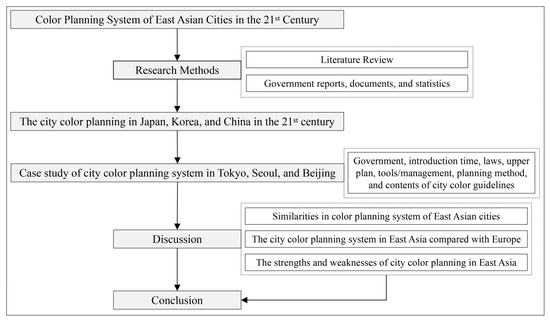
Figure 1.
Research flowchart.
Firstly, by searching relevant publications and news, and downloading documents from each city’s official websites, we counted the cities in each of the three countries that had completed special city color planning from 2000 to October 2022. It should be noted that we excluded cities that were researching color planning or were in the preparation stages of its formulation. Additionally, the city level of the statistics was limited to the second administrative level and above, including the ordinance-designated cities, nuclear cities, and cities in the Tokyo Prefecture in Japan (a total of 106 cities); the special cities, metropolitan cities, and provincial cities in South Korea (a total of 83 cities); and the municipalities and prefecture-level cities in China (a total of 337 cities).
Secondly, this research was addressed using a comparative framework that established several important indicators of city color planning systems through reviewing publications and academic research works, as well as documents downloaded from the official websites of each city.
Thirdly, regarding the discussion part, the first sub-phase was an exploration of the characteristics of East Asian city color planning systems in the 21st century based on the analysis conducted in the previous phases. The second sub-phase involved a comparison between the city color planning systems in East Asia and Europe, including a comparison of East Asian landscape law and the ELC and a comparison between East Asian city color guidelines and the color plan of Turin, Italy. In the third sub-phase, we summarized the strengths and weaknesses of each city color planning system in East Asia.
4. The Process of City Color Planning in Japan, Korea, and China in the 21st Century
Figure 2 shows the cities in Japan, South Korea, and China that completed special city color planning in the 21st century. In general, Japan’s city color planning started the earliest. After entering the 21st century, more cities began to formulate city color planning; however, in the early stage, these were mainly large cities and historical cities. After the introduction of the Landscape Law in 2004, several cities reformulated or revised their city color plans according to urban landscape planning. Thus far, cities with special city color planning are mainly concentrated in the Kanto (predominantly), Kinki, and Kyushu regions of Japan. Regarding South Korea, no cities implemented color planning before 2005, and most color planning took place after the Landscape Act in 2007. Accordingly, Seoul Special City was the first city in South Korea to establish city color guidelines, followed by Busan Metropolitan City. Currently, the cities that have completed city color planning in South Korea are mainly concentrated in the northwest, centering on Seoul; the central region, centering on Daejeon Metropolitan City; and the southeast, centering on Busan Metropolitan City. Relatively few cities in the northeast and southwest regions have completed city color planning in South Korea. The “Regulation on the Orderliness of the Building Facades of Beijing” (Order No. 56 of the Beijing Municipal People’s Government) initiated China’s city color planning in 2000. In 2001, Panjin City, Liaoning Province, formulated China’s first city color plan using the Color Planning Center of Japan as a consultant. Thereafter, cities such as Harbin, Wuhan, Xi’an, and Chengdu followed suit. To date, the cities that have established city color planning in China are mainly in Northeast China, North China, Central China, South China, and East China (predominantly), with fewer cities in the Southwest and Northwest. Among them, Panjin and Haerbin were the first to adopt city color planning in Northeast China, Beijing and Datong were the first in North China, Wuhan was the first in Central China, Guangzhou was the first in South China, Nanjing and Hangzhou were the first in East China, Xi’an was the first in Northwest China, and Chengdu and Chongqing were the first in Southwest China.
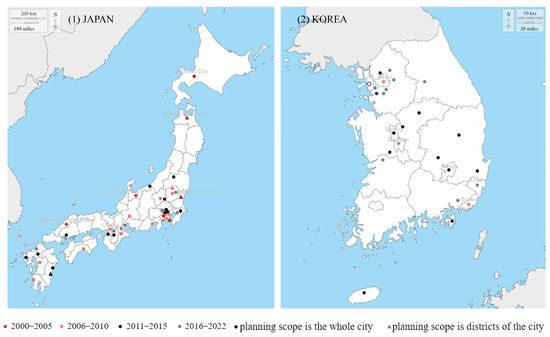
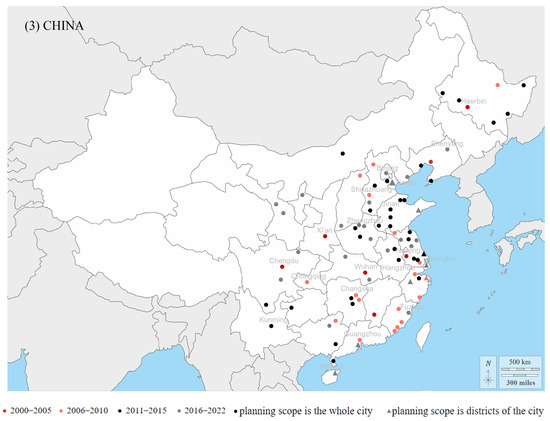
Figure 2.
Cities with established city color plans in Japan, South Korea, and China in the 21st century.
In summary, city color planning in Japan, South Korea, and China exploded in the 21st century. In particular, it surged in Japan between 2006 and 2015, that is, within 10 years of the introduction of the Landscape Law. Both South Korea and China experienced an explosion in city color planning from 2011 to the present. Additionally, the cities in Japan, South Korea, and China that carried out city color planning earlier are generally large cities, such as the ordinance-designated cities of Japan, the special cities and metropolitan cities of South Korea, the provincial capitals of China, and historical cities. It should be noted that several large, developed cities in Japan, South Korea, and China are also considered historical cities, for example, Tokyo, Japan, Seoul, South Korea, and Xi’an, China. While several cities have completed city color planning, others are still in the planning or exploration phase. In particular, the northern region of Japan, the southern region of South Korea, and the northwestern region of China lack city color planning. As shown in Table 3, from 2000 to October 2022, 41.51% of Japanese cities in Japan, 30.12% of Korean cities, and only 26.11% of Chinese cities completed city color planning. It is expected that more cities will formulate or update city color plans in the future.

Table 3.
The number of cities in Japan, South Korea, and China that have completed color planning in the 21st century.
5. Application: A Comparative Investigation of Color Planning Systems in Three Capital Cities
Table 4 illustrates a comparative framework of the city color planning systems of the selected cities in East Asia. Specifically, the data were clustered into seven domains to identify the following: government agency, introduction time, relevant laws, upper plan, tools/management, planning method, and text contents. This section includes three subsections, one for each city and country, and discusses the indicator documents reported in Table 4 and specific city color planning methods.

Table 4.
Descriptive framework of the selected cities in East Asia.
5.1. Tokyo, Japan
In the 1970s, as “the geography of color” concept proposed by French colorist Jean Philippe Lenclos extended into Japan, the country’s color research became richer. In 1971, the Tokyo Municipal Government and the Japan Color Planning Center conducted a comprehensive investigation of Tokyo’s city colors and formed a research report. Simultaneously, the rapid growth and renewal of Japanese cities after World War II created various landscape problems, which directly prompted the introduction of several landscape ordinances (Fu 2020). In 2004, Japan introduced the Landscape Law (Order No. 110 of laws) by summarizing past landscape policy experience and referencing European cases. Color is mentioned in the formulation of landscape planning in the Landscape Law in Article 7: “Restrictions on the form, color, and other designs) of buildings or structures”. Accordingly, in 2006, the Tokyo Landscape Ordinance (Order No. 136 of ordinances) was introduced, which stipulated the control of architectural colors. After the implementation of the landscape law and ordinances, the number of landscape plans formulated by landscape administrative groups gradually increased, and most mentioned the control of color (Hirata et al. 2013). Additionally, some cities launched special color guidelines. As can be seen in Figure 3, the Landscape Administrative Organization organizes the landscape association, which is responsible for the landscape consultation, and the Landscape Maintenance Organization is responsible for landscape management and maintenance. Simultaneously, policies such as landscape agreements, penalties, and tax support facilitate the landscape planning process. In 2007, the Bureau of Urban Development published the Color Scape Guidelines for Metropolitan Tokyo based on landscape planning of Tokyo.
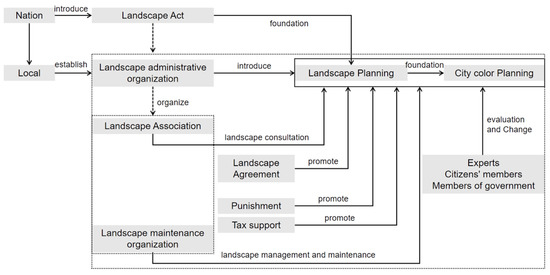
Figure 3.
City color planning system of Japan.
The method of The Color Scape Guidelines for Metropolitan Tokyo is mainly based on the theory of “The geography of color”, extracting natural geographic colors, humanistic and historical colors, and current colors, and emphasizing color harmony. The contents mainly comprise two sections, as shown in Figure 4. One is standard color guidelines, mainly referring to various landscape partitions in the Tokyo landscape plan, including landscape basic axes, landscape special zones, and general areas, and the color control of large-scale buildings and outdoor advertisements in different landscape areas. The other is the flexible use of color guidelines. The landscape formation standards for landscape planning require not only conformity to the numerical standards for colors but also harmony with the surrounding landscape as a unified standard. Therefore, the second section of the guidelines explains how to create a good relationship between the surrounding environment and building exteriors from the perspective of color in order to increase the effectiveness of landscape planning and create more attractive Tokyo cityscapes. Specifically, including the color design method according to the guideline standard, architectural colors with different perceptions, color design for distant, middle, and close views, and the operation of color standards. As color is an essential part of landscape, managing Tokyo’s color guidelines is consistent with landscape management, mainly including landscape agreement systems and prior consultation systems.
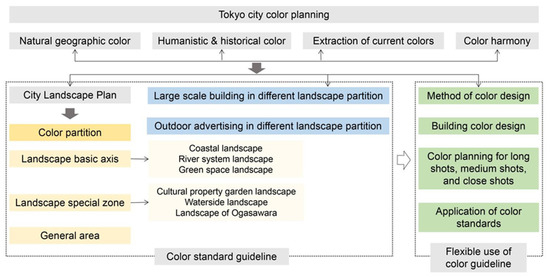
Figure 4.
Planning method and contents of Tokyo city color planning.
5.2. Seoul, South Korea
Influenced by Japan, scholars began to study Seoul’s city colors as early as the 1970s. For instance, Yoon (Yoon 1971) investigated the environmental colors of a commercial area in Seoul, while Kim (Kim 1975) researched the influence of architectural color on urban planning in the city. After entering the 21st century, the research increased. In November 2007, the South Korean Landscape Law (Order No. 8748) came into effect, among which Article 16 clearly mentions color: “Matters concerning design and color of buildings and outdoor advertisements” (Seo and Yamamoto 2012). From Figure 5, the landscape committee is responsible for the establishment and change of landscape planning and landscape projects. On the other hand, landscape agreements and financial support facilitate the implementation of landscape planning and projects. In 2008, the Seoul Metropolitan Government promulgated the Seoul Landscape Ordinance (Order No. 4628 of Seoul Ordinance). In the same year, to improve citizens’ quality of life by enhancing the urban landscape, the Seoul Metropolitan Government set out to formulate the Seoul Design Guidelines. Based on the above, the Design Seoul General Headquarters published the Seoul Establishment and Systematization of Seoul Colors in 2008 (Joo and Choi 2020). Additionally, color is also mentioned in Article 7 of the Seoul City Landscape Ordinance, which was revised in 2014 (Order No. 5715 of Seoul Ordinance): “Matters concerning the preservation, management, and formation of landscape include the matters related to landscape design, such as colors and materials.” This content was retained until the latest revised edition in 2020 (Order No. 7782 of Seoul Ordinance).
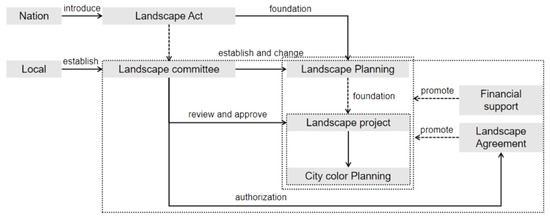
Figure 5.
City color planning system of Korea.
There are four parts to the Seoul Establishment and Systematization of Seoul Colors. The first part is a basic overview, including the research scope and methods. The second part includes an investigation of domestic and foreign cases and an analysis of the current situation. The third part details the establishment of Seoul’s colors, including status colors, regional colors, representative colors, keynote colors, and symbolic colors. The last part discusses the systematization of Seoul’s colors. Specifically, the establishment of Seoul colors primarily comes from natural geographic colors, humanistic historical colors, and current building colors based on the theory of “The geography of color” from Figure 6. First, 250 status colors were selected by the advisory council from 9800 digital photographs. Thereafter, 50 regional colors were selected by the advisory council from among status colors. Then, 10 representative colors were selected by experts and citizens through questionnaires. Finally, the keynote color, silver, and the symbolic color, red, were selected through a preference survey of experts and citizens. The systematization of Seoul’s colors mainly stipulates regional color guidelines and recommended colors for the city. The guidelines classify color zones according to the Seoul Landscape Plan; the regional colors were mainly extracted by taking digital photographs and on-site color research. Additionally, there are 600 recommended colors in Seoul based on combinations of the 250 status colors. Simultaneously, the guidelines also propose recommended colors for buildings, urban facilities, and outdoor advertisements. Regarding the management system, the Korean government published some application guidelines in various fields, such as the environmental, industrial, and fashion fields, to achieve systematic management. A color sample card was also published.
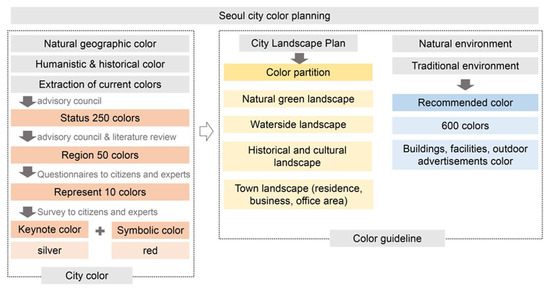
Figure 6.
Planning method and contents of Seoul city color planning.
5.3. Beijing, China
In 2000, the “Regulation on the Orderliness of the Building Facades of Beijing” (Order No. 56 of the Beijing Municipal People’s Government) determined that the main color of Beijing’s architecture should be gray. Beijing then started exploring and researching city color, and in 2017, the seventh edition of the Beijing City Master Plan was approved based on the Urban and Rural Planning Regulations of Beijing (Order No. 12 of the Beijing Municipal People’s Congress Standing Committee), which clearly stated that city color control should be strengthened. In the same year, the “Urban Design Management Measure” (Order No. 35 of the Ministry of Housing and Urban-Rural Development of China) was promulgated, which legally stipulated color control requirements in Article 10: “…pay attention to the scale of architectural space, and put forward control requirements such as building height, volume, style, and color…”. From Figure 7, The Urban and Rural Planning Regulations of Beijing and Urban Design Management Measure are formulated in accordance with the Urban and Rural Planning Law of the People’s Republic of China. In 2021, as a characteristic special design guideline under the Beijing City Master Plan, the Beijing Urban Color Urban Design Guidelines were authorized by the Beijing Municipal Commission of Planning and Natural Resources based on Beijing City Master Plan. Notably, the Beijing Urban Color Urban Design Guidelines implement unit grid management.
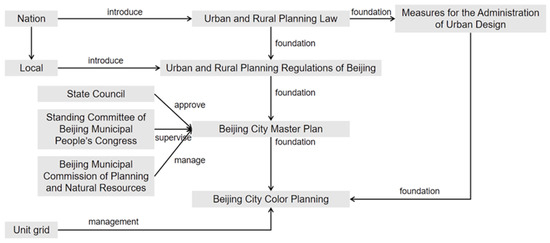
Figure 7.
City color planning system of Beijing.
Similarly, the planning method of Beijing’s city color is also based on the theory of “The geography of color”, extracting the natural geographic colors, humanistic colors, historical colors, and current colors of Beijing. There are six chapters in total in the Urban Design Guidelines for Beijing City Color. Among them, the first chapter, “Inheritance and Evolvement”, mainly reviews the characteristics of Beijing’s city colors during various historical periods from the Ming and Qing Dynasties to the present and then proposes the current problems and development orientations of Beijing’s city colors. The second chapter, “Urban Color Master Plan Pattern and Partition Characteristics”, clarifies the city’s color motif and divides the color control zoning according to the City Master Plan zoning. The third chapter, “Color Overview of the Ancient Capital Color Control Area”, is an extension of the second. The fourth chapter, “Building Type and Color”, includes royal buildings, traditional buildings, large modern landmark buildings, modern residential buildings, modern commercial buildings, modern public buildings, and industrial buildings as building categories. Additionally, it includes the color control requirements for building clusters. The following chapter, “Street Space and Color”, mainly lists the color control requirements for building roofs, floor paving, urban furniture, urban advertising, green landscape, and urban lighting. The last chapter is named “Mechanism Guarantee and Special Governance”. In sum, as seen in Figure 8, Beijing’s city colors are extracted from regional natural colors, cultural colors, historical colors, and existing architectural colors, forming the keynote colors, red and silver. Additionally, the recommended colors for each partition, different building types, and street spaces are formulated in the guidelines. Regarding management, the guidelines proposed zoning control and grid management, as well as creating a city color database and intelligent management system. However, few concrete measures and actions have been implemented. Furthermore, Beijing also published a color sample card.
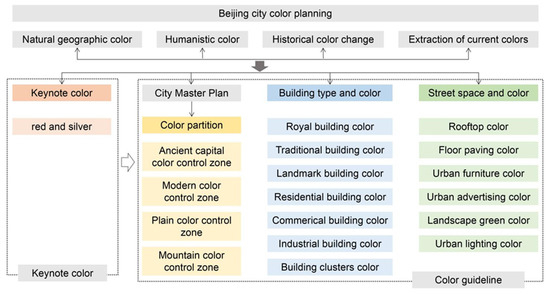
Figure 8.
Planning method and contents of Beijing city color planning.
6. Discussion
6.1. Similarities in the City Color Planning Systems of East Asian Cities
In sum, most of the city color planning in East Asian cities takes the form of top-down plans led by the government. Specifically, color planning includes color zoning, color extraction, and color management. Among them, color zoning methods are carried out according to upper planning zoning, such as city master plans or urban landscape plans. Each color partition has different color requirements. Additionally, different color requirements are planned for different elements of the city, especially the color of urban buildings. Regarding color extraction, the extraction methods of East Asian cities are mostly based on Lenclos’s theory of “the geography of color”. In the 1970s, Lenclos recorded city colors, including those of walls, windows, doors, and visible parts of roofs, and natural environment colors, such as vegetation, water, and the sky. His method of mapping city color consists of three stages; the first involves extracting color materials directly from the building and site, such as a part of a window, stones, or some soil. When collecting a sample is not possible, its color is recorded using a manually painted card. The second step is to synthesize the collected data. All the collected samples are translated to gouache-painted color cards that faithfully reproduce the original colors, a process that is known as interpreting-colored materials to colored cards. When a collection of colored cards is completed, they are classified into a series of panels that produce a color synthesis of both a site and its architectural elements. The third step is called systematic color conceptualizing. In this step, the survey selection and synthesis from the previous steps are formed as a collection of applied colors appropriate to a particular site, known as color palettes. Most of the color extraction methods in East Asian cities are based on the abovementioned Lenclos method. The main innovation has occurred in the first step, that is, taking pictures with a digital camera instead of sample material extraction. Colors are then extracted from the photos of the urban, natural, and artificial environment to eventually form the city color palettes. In most East Asian cities, color management is supported by laws and regulations linked to upper-level planning.
Additionally, the color system used in most East Asian cities is the Munsell color system, which intuitively represents the hue, value, and chroma of colors. The colors chosen in the color guidelines mainly include two aspects: one is the overall base color of the city, and the other is the color of the partition and details. The colors are divided into dominant colors, assorted colors, and accent colors; among them, the dominant color generally accounts for more than 70% of the color area. Table 5 presents the color requirements of the city color planning of Tokyo, Seoul, and Beijing, respectively. Seoul and Beijing have the same base colors of a red series and silver-gray. Among them, the red series in Beijing mainly comes from the palace walls, palace gates, red pillars, and red bricks of the Forbidden City, and the silver-gray mainly comes from the gray bricks and tiles of traditional courtyard houses. Seoul’s silvery white, meanwhile, mainly comes from the color of the Han River, the color of the clothes and porcelain of the Joseon Dynasty, and the color of the city’s mountains and rocks. Red, the symbolic color of Seoul, represents auspiciousness and brightness. Similarly, the Chinese also prefer red (Zhang et al. 2019). In fact, in East Asia, red has always symbolized good luck and brightness, and red is a higher grade in the five color systems in ancient China. Although base colors are not specified in Tokyo’s color guidelines, according to the overall color requirements, they are mainly red and yellow. Regarding partition colors, the dominant colors of these three cities are similar: The hues are mostly red (R), yellow (Y), and yellow-red (YR) with high value and low chroma. Additionally, there are more green series, including blue-green (BG) and green (G), in Seoul and Beijing’s guidelines, which originated from the cyan of the five colors of ancient China. East Asia, thus, has a preference for warm colors, especially red and yellow series, and is profoundly influenced by the traditional five colors.

Table 5.
Color requirements in the city color planning of Tokyo, Seoul, and Beijing.
6.2. City Color Planning Systems in East Asia COMPARED with those of Europe
Among East Asian countries, Japan’s landscape planning is relatively mature as it was the first to enact the Landscape Law in 2004. The ELC (ETS NO. 176) was adopted in Florence, Italy, in 2000 and was implemented on 1 March 2004. It is the first international treaty exclusively concerned with all dimensions of the European landscape (Senetra et al. 2015). Currently, 40 countries have ratified the ELC. While Japanese landscape law and the ELC both denote definitions, purposes, the obligations of all parties, and authorization processes, there are differences regarding the scope of the landscape (Figure 9). Specifically, Japan’s Landscape Law primarily focuses on promoting the preservation and enhancement of landscapes that are considered valuable, beautiful, and outstanding. However, within the ELC, the concept of landscape extends beyond exceptional views to encompass “everyday” or degraded landscapes as well. This inclusive approach recognizes that landscape encompasses all areas that are perceived by people, whether in urban or rural settings. Furthermore, the ELC is an international treaty; thus, it includes several articles on cooperation between parties, for example, international policies and programs, mutual assistance and the exchange of information, transfrontier landscapes, the monitoring of the implementation of the convention, and the Council of Europe’s Landscape Award. The Japanese Landscape Law, as a national law, is more detailed than the ELC; its main content covers landscape planning, landscape area, landscape agreement, and landscape maintenance. Additionally, Japan’s Landscape Law stipulates strict penalties for the violation of its regulations, such as imprisonment or fines. Moreover, the Landscape Law of Japan includes articles specifically addressing color aspects at a microscopic landscape level. In contrast, the ELC does not encompass color-related provisions, as it is an international treaty primarily focused on the broader perspective of the landscape. Consequently, through a comprehensive examination of the relevant laws pertaining to the urban landscape in Italy, leading to the “Code of the Cultural and Landscape Heritage, Italy” (No. 42 of 22 January 2004). This code establishes the legal framework for urban landscape planning in Italy. Notably, Article 154 of this code specifically addresses the issue of color in building facades: “Colour of Building Facades: the facades of the buildings whose colour jars with the beauty of the whole be given a different colour which is more in harmony with that beauty”. Based on the above, East Asia could learn from the terms of cooperation between the parties in the ELC. In other words, Japan, Korea, and China could seek more international cooperation on urban landscape and city color and work hard on the overall landscape of East Asia in the future.
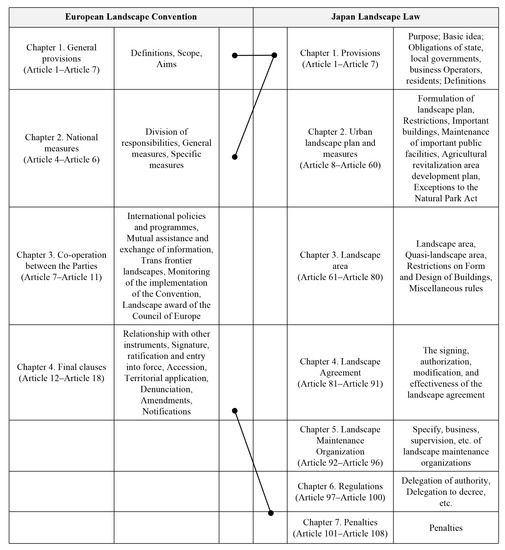
Figure 9.
Content of the Japanese Landscape Law and the ELC.
In Europe, research on city color started early in Italy, and its color plan is relatively mature. Since the first city color plan in the world was created in the 19th century by a council of constructors in Turin (Molavi 2015), this article compares Turin’s current color plan to city color guidelines in East Asia. Turin’s current color plan was approved by a resolution of the city council and published in 1997, as shown in Table 6. First, regarding nature, the color plan of Tokyo, Seoul, and Beijing is considered a guideline, that is, official advice with low mandatory requirements, whereas Turin’s color plan is a municipal regulation with legal effect and is mandatory. Second, the scope of planning is different: City color planning in East Asia generally targets the entire city, specifically, color planning in East Asia adopts zoning planning, that is, the entire urban area is divided into distinct planning zones and implements different color control requirements for each zone. However, Turin’s color plan mainly intervenes in historical areas, while there are few mandatory requirements for other urban areas. Simultaneously, the objectives of the planning are different: The government bodies in East Asia developed color guidelines to create a better urban landscape and improve the image of the cities, whereas Turin’s color plan aimed to conserve and protect its architectural heritage and the evolution of the community’s aesthetic appreciation of color. Third, the control of architectural color in Turin is more detailed, and the colors of external doors, windows, columns, and even courtyards that are visible from the outside have been controlled. In East Asia, controlling architectural color tends to be holistic. The control procedures also differ: Turin’s color plan does not have the color range of hue, lightness, and chroma and recommended colors such as the East Asian guidelines. In Turin, the municipal government has a professional color office that guides and controls color schemes. Specifically, for private users, a color form (and any other requirements) must be sent to the color office at least 30 days before a project commences. For municipal sectors, the municipal offices should be in contact with the color office and must organize site inspections to define the colors, materials, and application procedures of a project. The consultancy service is completed with the issuing of a report of indications that may provide authorization. Under no circumstances may painting or restoration work start without contact with or an inspection by the color office in advance. However, in East Asia, the procedure is simpler, and Japan generally only has a prior consultation system for large buildings.

Table 6.
Content of Turin’s color plan.
6.3. Strengths and Weaknesses of City Color Planning in East Asia in the 21st Century
This section discusses the strengths and weaknesses of the color planning systems of the three East Asian case study examples. We examine specific issues without ranking the systems and develop a comparative analysis methodology that can be adopted by other researchers to explore different color planning systems. Table 7 shows an overview of these results.

Table 7.
Strengths and weaknesses of the city color planning systems in East Asia in the 21st century.
Japan has a long history of laws and other regulations that govern landscape management and city color planning. Although landscape laws in South Korea are quite new, the legal system related to urban color planning is relatively complete. By contrast, there is no specific landscape law in China yet, the color planning legal system is chaotic, and the color planning in most cities has no legal basis. More specifically, color planning in Tokyo and Seoul, while relatively mature, has not been updated, and urban planning is a dynamic process that requires constant monitoring and improvement. Beijing, although has only recently introduced city color guidelines, the research on city color is earlier. Further, both Tokyo and Beijing demonstrate an intricate level of detail in the color guidelines, encompassing a wide range of building types and street space categories in their color control measures. In contrast, the guidelines in Seoul are comparatively less comprehensive in their coverage. Notably, the management of city color planning in East Asia is disorganized. For instance, Tokyo functions under the responsibility of the urban development department, Seoul functions under the design department, and Beijing functions under the planning department. Subsequently, we believe it would be in East Asia’s best interest to operate under one unified color office, as is the case in Italy. Simultaneously, city color planning in East Asia is a top-down planning process led by the government, with low public participation; we hope that a bottom-up planning system can be developed in the future.
7. Conclusions
Since the advent of the 21st century, with the promulgation of landscape laws and related landscape management regulations, city color, as a vital component of the urban landscape, has garnered increasing attention. To explore the characteristics of the city color planning systems of East Asia in the 21st century, this study mainly adopted qualitative comparative analysis methods using Tokyo, Seoul, and Beijing as case study examples. We used publications, academic research, and official documents clustered into seven domains to identify the following: government agency, introduction time, relevant laws, upper plan, tools/management, planning method, and planning contents. The key findings are as follows.
First, in Japan, cities with special city color planning were mainly concentrated in the Kanto (predominantly), Kinki, and Kyushu regions. In South Korea, the cities that have completed city color planning were mainly concentrated around the metropolitan cities in the northwest, the center, and the southeast regions. In China, the cities that have established city color planning were mainly in the northeast, north, center, south, and east (in particular), with fewer relevant examples in the southwest and northwest. Additionally, the cities in Japan, South Korea, and China that implemented city color planning earlier were generally large cities and historical cities.
Second, compared with Europe, city color planning systems in East Asia exhibited notable similarities, including their formulation process, planning methods and selected colors. Specifically, most of the city color planning in East Asian cities was a top-down process led by the government. Regarding color extraction, East Asian extraction methods were mostly based on Lenclos’s theory of “the geography of color”. City color guidelines in East Asia had a preference for warm colors, especially red and yellow series, and the five traditional colors of ancient China had a profound influence on them.
Third, among the three East Asian countries, Japan boasted the earliest and most comprehensive legal framework for a city color planning system, whereas China’s initiation of city color planning occurred relatively later, resulting in a currently fragmented legal system in this regard. Moreover, the city color planning systems of China, Japan, and South Korea have obvious deficiencies in the professionalism of the planning authorities and public participation. It is recommended that the governments in East Asia set up a color office in the future to carry out color planning and management more professionally, and more international cooperation could be sought across East Asia. Finally, further improving relevant laws and regulations, developing bottom-up planning methods, updating color guidelines timely, and promoting public participation are promising means of developing an East Asian model of city color planning.
The findings of this study offer valuable insights into the future of city color planning in East Asia, contributing to the enhancement of urban landscapes and the development of unique city identities. However, there may be some possible limitations in this study. Firstly, not all cities in East Asia have readily accessible official information regarding their city color planning initiatives. To overcome this limitation, publications and news sources have been utilized as supplementary references. However, it is important to acknowledge that there may be potential errors due to the reliance on these sources. Secondly, this article primarily focused on Tokyo, Seoul, and Beijing as case studies, which constitutes a relatively small number of cases. In future research, expanding the scope to include additional cities would provide a broader range of references for the East Asian city color planning system. Thirdly, the methodology adopted in this study uses qualitative indicators to investigate the city color planning system in East Asia. Future research could incorporate quantitative research methods, such as color measurement and surveys of residents’ color preferences. By integrating these approaches, a more comprehensive exploration and evaluation of the characteristics of East Asian city color planning systems could be achieved.
Author Contributions
Conceptualization, Y.W., Y.H. and J.C.; methodology, Y.W. and J.C.; formal analysis, Y.W. and J.C.; investigation, Y.W., Y.H. and J.C.; resources, Y.W., Y.H. and J.C.; writing—original draft preparation, Y.W.; writing—review and editing, Y.H. and J.C.; visualization, Y.W.; supervision, J.C.; project administration, Y.H. and J.C.; funding acquisition, Y.H. All authors have read and agreed to the published version of the manuscript.
Funding
This research was supported by Japan Society for the Promotion of Science, JSPS KAKENHI Grant Numbers JP25420639 (Yuka HIMENO), JP23H03646 (Yuka HIMENO). And the APC was funded by Japan Society for the Promotion of Science.
Institutional Review Board Statement
Not applicable.
Informed Consent Statement
Not applicable.
Data Availability Statement
Not applicable.
Conflicts of Interest
The authors declare no conflict of interest.
References
- Baek, Tae-Kyung, and Sampei Yamashita. 2013. A Comparative Study on the Landscape Planning System of Asia. Journal of the Korean Association of Geographic Information Studies 16: 26–35. [Google Scholar] [CrossRef]
- Behbudi, Reyhaneh, Idid Szasa, and Mahdi Torabi. 2012. The Functions of Color in Urban Setting. Paper presented at the Aceh Development International Conference (ADIC 2012), Kuala Lumpur, Malaysia, March 26–28. [Google Scholar]
- Cabanillas, Jaraíz, Francisco Javier, Julián Mora Aliseda, José Antonio Gutiérrez Gallego, and Jin Su Jeong. 2013. Comparison of Regional Planning Strategies: Countywide General Plans in USA and Territorial Plans in Spain. Land Use Policy 30: 758–73. [Google Scholar] [CrossRef]
- Caivano, José Luis. 2006. Research on Color in Architecture and Environmental Design: Brief History, Current Developments, and Possible Future. Color Research & Application 31: 350–63. [Google Scholar] [CrossRef]
- Chen, Naige, Xiaofan Xu, Minghong Tan, and Xianming Wang. 2022. A Spatial Analysis of Urban Color Harmony in Five Global Metropolises. Journal of Resources and Ecology 13: 238–46. [Google Scholar] [CrossRef]
- Choe, Pilsung, Pei-Luen Patrick Rau, and Gicheol Jeon. 2013. Cross-Cultural Comparisons of Customer Perception at Restaurant Franchises in Beijing, Tokyo, and Seoul. Journal of Korean Institute of Industrial Engineers 39: 239–46. [Google Scholar] [CrossRef]
- Correy, Allan. 1982. Visual Perception and Scenic Assessment in Australia. XX World Congress IFLA+ AILA, 169–83. [Google Scholar]
- De Montis, Andrea. 2014. Impacts of the European Landscape Convention on National Planning Systems: A Comparative Investigation of Six Case Studies. Landscape and Urban Planning 124: 53–65. [Google Scholar] [CrossRef]
- De Montis, Andrea. 2016. Measuring the Performance of Planning: The Conformance of Italian Landscape Planning Practices with the European Landscape Convention. European Planning Studies 24: 1727–45. [Google Scholar] [CrossRef]
- Déjeant-Pons, Maguelonne. 2006. The European Landscape Convention. Landscape Research 31: 363–84. [Google Scholar] [CrossRef]
- Dusenbury, Mary. 2015. Color in Ancient and Medieval East Asia. Lawrence: Spencer Museum of Art, University of Kansas. [Google Scholar]
- Fu, Shulan. 2018. Study on the Formulation Approach of Japanese ‘Landscape Law’: Focusing on the Key Researcher Yukio Nishimura and His Methodology Framework. Urban Planning International 33: 145–51. [Google Scholar]
- Fu, Shulan. 2020. The Formation of the Legal System for Modern Planning in China before 1950: Comparison with Japan’s 1919 Act. Journal of Asian Architecture and Building Engineering 19: 285–94. [Google Scholar] [CrossRef]
- Gao, Jie, Wei Qian, and Lin Guangsi. 2016. Legislative Study on Japanese Law on Landscape. Modern Urban Research 31: 93–98. [Google Scholar]
- Hack, Gary, and Roger Simmonds, eds. 2013. Global City Regions: Their Emerging Forms. Abingdon: Routledge. [Google Scholar]
- Hemmert, Martin, Adam R. Cross, Ying Cheng, Jae-Jin Kim, Florian Kohlbacher, Masahiro Kotosaka, Franz Waldenberger, and Leven J. Zheng. 2019. The distinctiveness and diversity of entrepreneurial ecosystems in China, Japan, and South Korea: An exploratory analysis. Asian Business & Management 18: 211–47. [Google Scholar]
- Hirata, Norie, Yu Okamura, and Susumu Kawahara. 2013. A Study on Place Branding using Color Guidelines in Landscape Planning: Focusing on Expressions which Specify Recommended Symbolic Colors. Journal of Architecture and Planning 78: 663–71. [Google Scholar] [CrossRef]
- Hong, Xiaochun, Xiang Ji, and Zihan Wu. 2022. Architectural colour planning strategy and planning implementation evaluation of historical and cultural cities based on different urban zones in Xuzhou (China). Color Research & Application 47: 424–53. [Google Scholar] [CrossRef]
- Jang, Ye-Sook. 2014. Urban Landscape Color Planning. The Journal of the Korea Contents Association 12: 51–54. [Google Scholar]
- Joo, Jung Hee, and Gyoung Sil Choi. 2020. Research on the Factors that Form the Color Identity in Seoul. Journal of Korea Society of Color Studies 34: 5–16. [Google Scholar] [CrossRef]
- Kim, Heung-Gon. 1975. A Study on the Exterior and Interior Colors for City Building. Review of Architecture and Building Science 19: 35–38. [Google Scholar]
- Kim, Heung-Soon. 2009. Disputes on the Capital Transfer in the Early Stage of the Joseon Dynasty. Journal of Korea Planners Association 44: 21–36. [Google Scholar]
- Kim, Hyung Min, and Sun Sheng Han. 2012. Seoul. Cities 29: 142–54. [Google Scholar] [CrossRef]
- Kim, Seongho, Byeonguk Shin, and Woonggu Lee. 2020. A Study on the Applying Landscape Planning Elements through Urban Regeneration Cases in Local Cities. Journal of the Korean Institute of Rural Architecture 22: 51–62. [Google Scholar] [CrossRef]
- Kim, Sun Young. 2017. Comparison of Color in Seoul and Tokyo’s Color Guideline of 21st-Century Northeast Asia Accumulated Urban. Journal of Korea Society of Color Studies 31: 53–62. [Google Scholar]
- Kodera, S. 1993. Laws, Ordinances, and Regulations in Japan Concerning Colors of Various Structures. AIC, Japan Color 93: 15–35. [Google Scholar]
- Krajewski, Piotr, and Iga Solecka. 2019. Management System of Urban Landscape in Poland on the Example of Wroclaw in the Context of European Landscape Convention Implementation. In IOP Conference Series: Materials Science and Engineering. Bristol: IOP Publishing, vol. 471. [Google Scholar] [CrossRef]
- Kuriyama, Naoko, and Koichi Miwa. 2014. Study on the Present Use and the Role of the Landscape Guidelines in the Landscape Administration. Journal of the City Planning Institute of Japan 49: 741–46. [Google Scholar] [CrossRef]
- Lee, Seong-Chang, Hyun-Chan Bahk, and Sang-Ho Yi. 2011. A Study on the Scheme to Increase the Efficiency of Urban Landscape Management of Seoul-Comparing the Urban Landscape Plans of Main Japanese Cities. The Journal of Korean Architecture 27: 211–20. [Google Scholar]
- Li, Luke. 2016. Symbol or Not: Research on the Color Design Ideology of Ancient Chinese Architecture. World Architecture 7: 34–41. [Google Scholar]
- Lim, Jung-Min, and Jun-Do Yun. 2011. The Activation of Residents Participation for the Local Landscape Improvement-With Special Emphasis on the Landscape Legal System and Case Study in Japan. KIEAE Journal 11: 43–53. [Google Scholar]
- Liu, Taotao. 2009. Beijing’s Historical Tradition and Modernization. Beijing: Capital Normal University. [Google Scholar]
- Lv, Yingxia. 2008. Research on the Cultural Idea and Cultural Expression of Traditional Chinese Architecture Color. Master’s dissertation, Harbin Institute of Technology, Harbin, China. [Google Scholar]
- Marine, Nicolas. 2022. Landscape Assessment Methods Derived from the European Landscape Convention: Comparison of Three Spanish Cases. Earth 3: 522–36. [Google Scholar] [CrossRef]
- Molavi, Mehrnaz. 2015. Preserving City Color Plan, Surveying Iranian Submontane Cities. Urbanism Architecture Constructions 6: 7–18. [Google Scholar]
- Nakao, Sanae. 1990. A Study on Streetscape and the Destrict Character: The Composition of Streetscape in Reference to Color. Design Studies 79: 7–14. [Google Scholar]
- Narita, Ikuko. 2018. Relation of the Good Color Landscape Formation and Landscape Plan. Journal of the Color Science Association of Japan 42: 147. [Google Scholar]
- Senetra, Adam, Monika Wasilewicz-Pszczółkowska, and Elżbieta Grzelak-Kostulska. 2015. The European Landscape Convention as a Tool for the Protection, Management and Planning of Landscapes. Barometr Regionalny: Analizy i Prognozy 13: 81–88. [Google Scholar] [CrossRef]
- Seo, Minjung, and Sari Yamamoto. 2012. Guidelines for Environmental Color Design in Seoul Korea Focused on Color Guideline among the Seoul Design Guideline Policy. In Proceedings of the 59th Annual Conference of the JSSD. Tokyo: Japanese Society for the Science of Design. [Google Scholar] [CrossRef]
- Serra, Juan, and Ángela García Codoñer. 2014. Color Composition in Postmodern Western Architecture. Color Research & Application 39: 399–412. [Google Scholar] [CrossRef]
- Takagi, Yuri, Koichi Kana, and Hongwei Hsiao. 2021. A Study on the Characteristics of Landscape Management by Area Management Organization in the Core Area of Large Cities. Journal of the City Planning Institute of Japan 56: 461–68. [Google Scholar] [CrossRef]
- Wan, Yim King Penny. 2013. A Comparison of the Governance of Tourism Planning in the Two Special Administrative Regions (SARs) of China–Hong Kong and Macao. Tourism Management 36: 164–77. [Google Scholar] [CrossRef]
- Wang, Guanyi, and Xu Lu. 2020. How Was the Color Harmony Thought to be Positioned and Applied in Japan’s landscape color planning? Urban Planning International 36: 1–15. [Google Scholar] [CrossRef]
- Wang, Guanyi. 2019. Research on Urban Color Planning System in Japan. Master dissertation, Shenyang Jianzhu University, Shenyang, China. [Google Scholar]
- Wang, Jiangbo, Lingyun Zhang, and Aiping Gou. 2020. Study on the preference of city color image selection based on the logistic model: A case study of Shanghai. Color Research & Application 45: 542–57. [Google Scholar] [CrossRef]
- Wen, Yajun, Yuka Himeno, and Jaehoon Chung. 2023. Potential conflicts between individual preferences and city color planning: A case study of Busan, South Korea. Journal of Asian Architecture and Building Engineering, 1–16, Not officially published. [Google Scholar] [CrossRef]
- Wu, Mingyi, and Yuchen Feng. 2022. The Context of Color: A Study on the Visual Color of the City—Taking Chengdu as an Example. Art and Design Review 10: 29–40. [Google Scholar] [CrossRef]
- Xu, Jie. 2023. A linguistic approach to urban color design and research—Exploring Jianming Song’s methodologies. Color Research & Application. Not officially published. [Google Scholar] [CrossRef]
- Yoon, Il-Choo. 1971. An Investigation of Environmental Colors of a Commercial Area in Seoul. Review of Architecture and Building Science 15: 3–6. [Google Scholar]
- Zhang, Mengyao. 2020. A Comparative Study of Landscape Management in China and Japan. Xiandai Horticulture 20: 228–31. [Google Scholar]
- Zhang, Shu, Yijie Liu, and Hong Nie. 2014. Geographical Feature Based Research on Urban Color Environment—Taking Wuhan as an Example. IERI Procedia 9: 190–95. [Google Scholar] [CrossRef]
- Zhang, Yujing, Pingping Liu, Buxin Han, and Liqin Li. 2019. Hue, Chroma, and Lightness Preference in Chinese Adults: Age and Gender Differences. Color Research & Application 44: 967–80. [Google Scholar] [CrossRef]
Disclaimer/Publisher’s Note: The statements, opinions and data contained in all publications are solely those of the individual author(s) and contributor(s) and not of MDPI and/or the editor(s). MDPI and/or the editor(s) disclaim responsibility for any injury to people or property resulting from any ideas, methods, instructions or products referred to in the content. |
© 2023 by the authors. Licensee MDPI, Basel, Switzerland. This article is an open access article distributed under the terms and conditions of the Creative Commons Attribution (CC BY) license (https://creativecommons.org/licenses/by/4.0/).